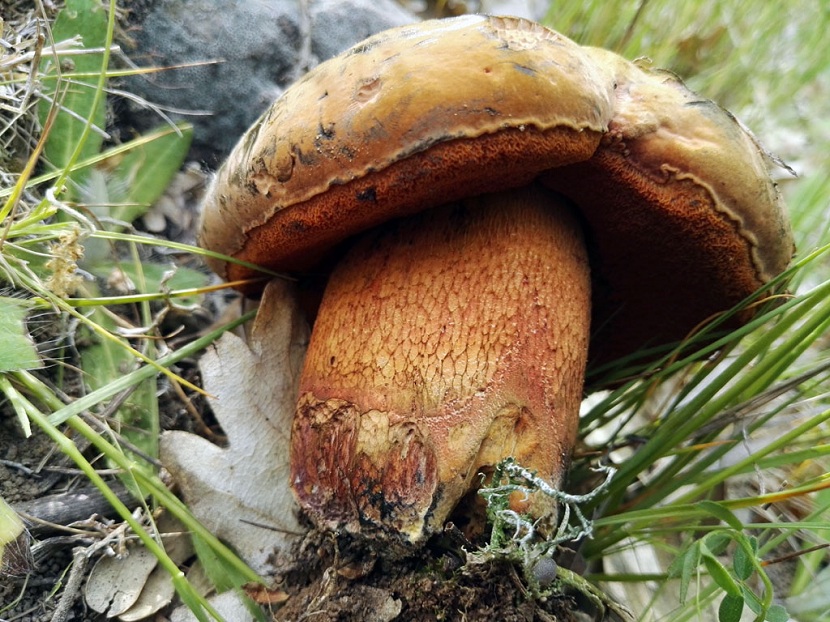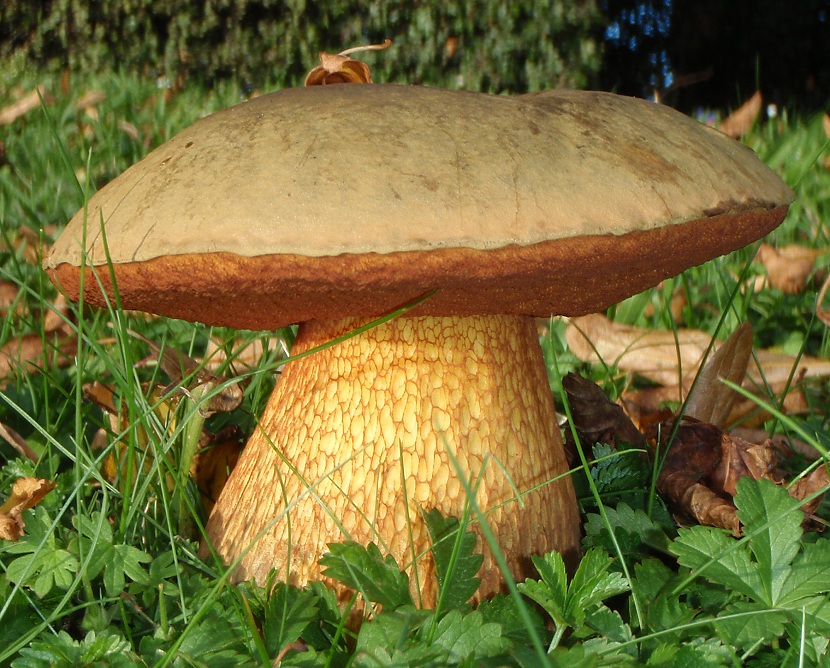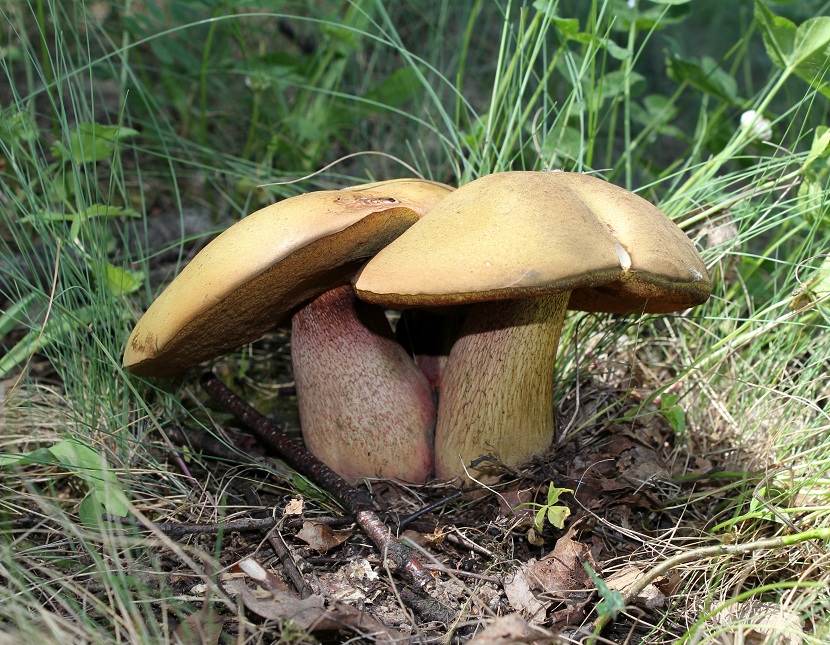
Today we are going to talk about another species of the genus Boletus. We talk about Boletus luridus. It is known by the name of boleto or sallow and it is a fungus that belongs to the Basidiomycetes group and to the Boletaceae family. This fungus can be found both in dense forests and in coniferous forests. Its name comes from the Latin pale and discolored and they refer to its scientific name. Although it has a sweet taste, it is a toxic mushroom.
In this article we are going to tell you all the characteristics and biology of the Boletus laridus so you can learn to differentiate it from other mushrooms that are edible.
Key features

This mushroom has a hat that measures between 4 and 16 centimeters in diameter. At first it has a hemispherical shape but later it gradually flattens until it becomes convex. It has a cuticle that is difficult to separate and has a variable color that can range from orange-ocher with olive-colored areas in its youth to a leather-like brown color when it has begun to mature.
When this mushroom is young it has a soft velvety texture and is quite sensitive to rubbing. It is one of the species that turn blue when cut or pressed. His hymenium has free tubes and they are separated from the flesh. They have a pale yellow color and evolve to a green color as they develop into adulthood. It has very small pores with a round shape. They are yellowish orange in color and, as they develop, they turn red. The hymenium turns blue immediately upon rubbing.
As for the foot, it has dimensions of between 5 and 12 centimeters in height and between 2 to 5 centimeters in diameter. Its shape is cylindrical and claviform. At the apex we find a yellow color that darkens towards the base. This part of the fungus also turns blue when damaged.
Its meat is quite thick and compact and has yellow or cream tones. They also turn blue when cut. This color becomes lighter on the surface being a wine style color, that is, a beet purple color at the base of the foot. After a while this color intensifies to blue. All tubes remain pale yellowish to pinkish in color. As we have mentioned before, the hymenium is easily separable from the meat and we can see that under this hymenium the meat has a pinkish orange color.
The smell of this mushroom is mild and with a sweet taste.
Ecology and edibility of Boletus luridus

It is a species that bears fruit during the late spring season and lasts until mid-autumn. In stormy summers we obtain a greater number of specimens per unit area. It prefers deciduous forests that have a soil that is siliceous in nature. They support basic soils although, actually, they can appear in almost all kinds of forests.
They just need a high level of humidity and an intermediate to high rainfall regime. As for its edibility, we have to cook it since if it is eaten both raw and rare it can be slightly toxic. If it is well cooked, it has a good sweet taste and a pleasant texture. Thanks to this type of mushroom, really exquisite dishes can be prepared. There are several authors who affirm that the Boletus luridus and increases its danger to the time to eat it if it is done both raw and accompanied by alcoholic beverages.
Confusions of the Boletus luridus

There are some species of Boletus that have a very similar morphology and, therefore, we can confuse it when collecting them. We are going to analyze one by one the main species for which we can confuse the Boletus luridus and how to differentiate them:
- Suillellus caucasicus: It has a huge part and it only differs in that the meat under the hymenium is yellow and not reddish as occurs with the Boletus luridus.
- Suillellus queletii: this species has a yellower foot and does not have cross-linking. It is not well known if it is a toxic or edible species, but when in doubt, it is better not to consume it.
- Boletus satanas: this specimen of the same genus has an almost white cuticle and does not have ocher tones. Its foot is less reticulated and with a more reddish color. In general, it is a mushroom with a more robust size and its flesh, although it also turns blue with the cut and pressure, makes it a more subdued blue color.
- Boletus erythropus: the difference with this mushroom of the genus Boletus is that it has a pointed foot and is not reticulated either. This is a good edible.
Observations and curiosities

El Boletus luridus of a species very characterized by having orange-red pores and a highly reticulated foot. We could use these main characteristics to be able to differentiate this mushroom from others that may have a similar appearance. It is quite variable from the morphological point of view since it can grow in different types of forest.
Due to its great variability we can find it with a large number of varieties and shapes. In Extremadura, it is quite common to find some isolated specimens but very few. On some occasions and depending on the intensity of the rainfall we can find it locally and very abundantly. A curious fact for its identification is the dark vinous color that takes the part of the base of the foot.
Let's not forget that it is a species that must be cooked well so that it is not toxic in our body. Nor should we mix it with alcoholic beverages. The best time and location to collect them is to find it in small groups that are born from summer to autumn under species such as chestnut, cork oak and Pyrenean oak. It also tends to grow under holm oaks. Prefers limestone soils.
I hope that with this information you can learn more about the Boletus luridus and they can collect them and confuse it with other species.
Thank you for this long and complete explanation of the boletus luridus. It has helped me to classify some that I have found today. I have followed your instructions and I have observed each of the parts of the boletus, I have touched, scraped and cut, I have smelled, I have separated the pores... I have only lacked to try them (never if it is not a species that I am used to collecting ) Thanks again.
Thanks for your comment, Susan. If you have the opportunity, it is highly recommended to go out for mushrooms with people who know about the subject. I don't know if there is any mycology association in your area, but if you like that world, it's an opportunity to meet not only mushrooms, but also new people.
A greeting.